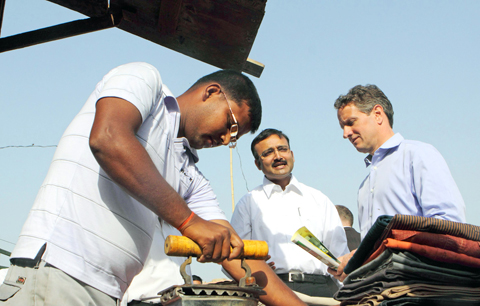US Treasury Secretary Timothy Geithner met Indian Prime Minister Manmohan Singh in New Delhi yesterday for talks to boost ties that are often eclipsed by Washington’s trade with China.
Geithner, beginning a two-day maiden visit as treasury secretary to India, is focusing on enhancing trade and investment with the surging economy and improving global financial stability.
Geithner met Singh for half an hour, an Indian official said, and was later meeting Indian Finance Minister Pranab Mukherjee to press India to open up its highly regulated markets to US investment.

PHOTO: BLOOMBERG
Washington says freer Indian markets could give the emerging nation cheaper access to capital to finance the billions of dollars needed to overhaul its dilapidated infrastructure, seen as a restraint to higher economic growth.
“We have a huge mutual stake in closer economic ties,” said Geithner, who is accompanied by other senior treasury officials and US Federal Reserve Vice Chairman Donald Kohn.
Geithner was in New Delhi to help formally launch the new US-India Economic and Financial Partnership as he promotes a long-term strategy to give India more parity with China in the US trade mindset.
The project, announced in November by US President Barack Obama during a visit by Singh to Washington, will spur regular Cabinet-level meetings in line with a similar dialogue between the US and China.
Geithner, who spent part of his childhood in India when his father worked for the Ford Foundation, said he also wanted “to build a much stronger cooperative partnership with India on broader global financial issues.”
He said he was keen to talk to Indian policymakers about tightening global standards for controlling risk as markets become more integrated in the wake of the worldwide financial crisis.
“Naturally when we’re holding discussions before the spring meetings of the IMF, World Bank and G20, all those issues will come up,” Mukherjee said.
Bilateral relations have blossomed after years of Cold War mistrust, Indian unease about close US ties with Pakistan and Washington’s displeasure over New Delhi’s acquisition of a nuclear bomb.
Last month, the two countries signed a trade and investment cooperation framework which US Trade Representative Ron Kirk said would tap the “almost limitless potential” of their trade relationship.
“This trip is significant just for the fact that it is happening,” Arvind Subramanian of the Peterson Institute for International Economics said.
“First and foremost, this trip is about symbolism, aimed at establishing a parallelism with the US-China relationship,” he wrote in a recent commentary.
Trade between India and the US has roughly doubled in the last five years as India has become one of the world’s foremost emerging markets.
However, that relationship, for years focused on trade and outsourcing, is increasingly looking toward investment.
Bilateral foreign direct investment reached US$21 billion in 2008, according to the treasury, a pittance compared with flows between the US and Europe or China.
“One reason I am going to India is to get a better sense of what is happening there — both in the economy and the broad reform process in the financial sector,” Geithner said.
He is scheduled to visit Mumbai, India’s business and financial capital, today.

Authorities have detained three former Taiwan Semiconductor Manufacturing Co (TMSC, 台積電) employees on suspicion of compromising classified technology used in making 2-nanometer chips, the Taiwan High Prosecutors’ Office said yesterday. Prosecutors are holding a former TSMC engineer surnamed Chen (陳) and two recently sacked TSMC engineers, including one person surnamed Wu (吳) in detention with restricted communication, following an investigation launched on July 25, a statement said. The announcement came a day after Nikkei Asia reported on the technology theft in an exclusive story, saying TSMC had fired two workers for contravening data rules on advanced chipmaking technology. Two-nanometer wafers are the most

NEW GEAR: On top of the new Tien Kung IV air defense missiles, the military is expected to place orders for a new combat vehicle next year for delivery in 2028 Mass production of Tien Kung IV (Sky Bow IV) missiles is expected to start next year, with plans to order 122 pods, the Ministry of National Defense’s (MND) latest list of regulated military material showed. The document said that the armed forces would obtain 46 pods of the air defense missiles next year and 76 pods the year after that. The Tien Kung IV is designed to intercept cruise missiles and ballistic missiles to an altitude of 70km, compared with the 60km maximum altitude achieved by the Missile Segment Enhancement variant of PAC-3 systems. A defense source said yesterday that the number of

A bipartisan group of US representatives have introduced a draft US-Taiwan Defense Innovation Partnership bill, aimed at accelerating defense technology collaboration between Taiwan and the US in response to ongoing aggression by the Chinese Communist Party (CCP). The bill was introduced by US representatives Zach Nunn and Jill Tokuda, with US House Select Committee on the Chinese Communist Party Chairman John Moolenaar and US Representative Ashley Hinson joining as original cosponsors, a news release issued by Tokuda’s office on Thursday said. The draft bill “directs the US Department of Defense to work directly with Taiwan’s Ministry of National Defense through their respective

Tsunami waves were possible in three areas of Kamchatka in Russia’s Far East, the Russian Ministry for Emergency Services said yesterday after a magnitude 7.0 earthquake hit the nearby Kuril Islands. “The expected wave heights are low, but you must still move away from the shore,” the ministry said on the Telegram messaging app, after the latest seismic activity in the area. However, the Pacific Tsunami Warning System in Hawaii said there was no tsunami warning after the quake. The Russian tsunami alert was later canceled. Overnight, the Krasheninnikov volcano in Kamchatka erupted for the first time in 600 years, Russia’s RIA